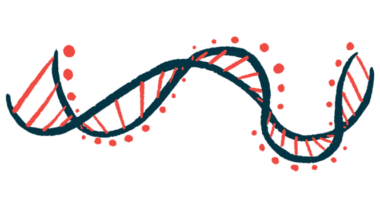Gene variant may advance ALS onset by about 3 years: Study
Disease seen 2.86 years earlier in men with variant, 3.25 years earlier in women

A particular genetic variant that boosts the activity of the NEAT1 gene can push the onset of amyotrophic lateral sclerosis (ALS) forward by more than three years, according to data from a large patient group in China.
While the exact function of NEAT1 in ALS needs to be explored, the findings shed light on the genetic mechanisms underlying the disease’s timing and provide a potential treatment target for delaying ALS onset or slowing its progression.
They also might help in explaining the considerable “heterogeneity in the age at [disease] onset” seen among patients, its researchers wrote.
The study, “Genome-wide analyses identify NEAT1 as genetic modifier of age at onset of amyotrophic lateral sclerosis,” was published in the journal Molecular Neurodegeneration.
An earlier age of ALS onset thought to affect symptom severity
While ALS can develop at any age, it typically occurs between ages 45-49 in women and 55-59 in men, the study noted.
The earlier the disease emerges has been shown to influence the severity of ALS symptoms, the rate of disease progression, and survival. “However, the mechanisms underlying the heterogeneity in [ALS onset age] … are complex and still poorly understood,” the researchers wrote.
A person’s genetic makeup is known to play a role in determining ALS risk, and a study in patients in Europe suggested it also can contribute to disease onset. Less is known about how genetic risk factors might affect onset in Asian populations.
“Identifying genetic modifiers for [age at onset] of ALS could help provide additional insights into the disease mechanisms and find out therapeutic options that may postpone the disease onset,” the researchers wrote.
Researchers at Sichuan University conducted a genome-wide association study in a large Chinese population to help identify such factors.
This type of study involves scanning the genome — the entire set of DNA instructions found in cells — of hundreds or thousands of people to look for genetic variants, or gene changes, that occur more frequently in those with a certain characteristic, such as earlier ALS onset.
They initially drew on data covering 2,230 patients (1,301 males and 929 females) whose average age at disease onset was 54.56 years. In this analysis, two genetic variants, rs6801884 and rs10128627, were significantly associated with an earlier age at onset.
rs10128627 variant tied to ALS onset that’s about 3.15 years earlier
Only the rs10128627 variant, however, remained significantly associated with onset in a smaller group of 558 patients (331 males and 227 females) studied next. The other variant showed no association in this group.
Combining data covering all 2,841 patients, the team found that people with the rs10128627 variant developed the disease about 3.15 years earlier than those without it. This effect was similar across patients, with onset age 2.86 years earlier for males with this variant and 3.25 years earlier for females.
The researchers mapped this variant to a gene called FRMD8, but additional analyses suggested the variant’s effects likely came through influencing the activity of the NEAT1 gene in multiple brain tissues and in the blood.
In fact, the activity of NEAT1 was significantly higher in patients with the rs10128627 variant than in other patients. Tests in lab-grown cells also found that a change in a single DNA building block within rs10128627 was enough to turn on the NEAT1 gene — in the sense of significantly increasing its expression. (Gene expression, also called gene activity, is the process by which information in a gene is converted to create a product, like a protein.)
“Collective evidence from genetic, bioinformatic, and functional results suggested NEAT1 as a key player in the disease progression of ALS,” the researchers wrote.
NEAT1 codes for a long noncoding RNA that is not translated into a working protein. But the molecule seems to regulate a number of ALS-associated proteins, including the TDP-43 protein that folds abnormally and builds as toxic clumps in most patients, triggering damage.
Previous work has shown that NEAT1 is abundant in neurons in the brain’s outermost layer and in the spinal cord of ALS patients, and that it may be linked to more severe disease. But its exact role still needs to be determined.
“These findings improve the current understanding of the genetic role in [age at onset] of ALS, and provide a novel target for further research on the pathogenesis [disease mechanisms] and therapeutic options to delay the disease onset,” the researchers concluded.







